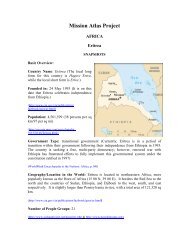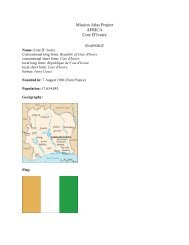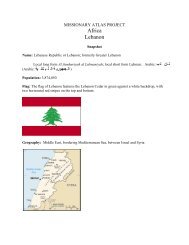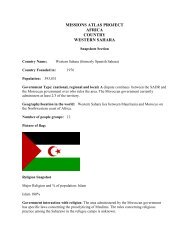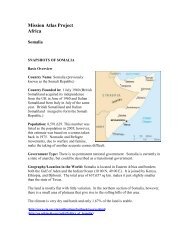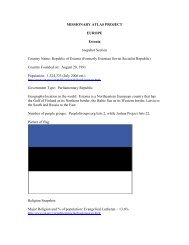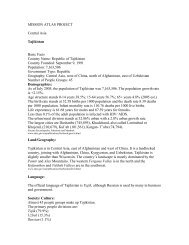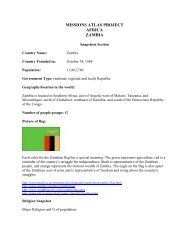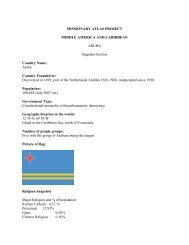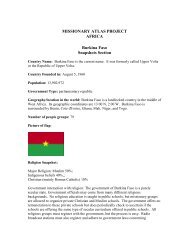Tanzania Profile.pdf - WorldMap
Tanzania Profile.pdf - WorldMap
Tanzania Profile.pdf - WorldMap
Create successful ePaper yourself
Turn your PDF publications into a flip-book with our unique Google optimized e-Paper software.
25˚-31˚C (77˚-87˚F). The coldest season is between May and August with temperatures rangingfrom 15˚-20˚C (59-68˚F).Source: http://www.earthrights.net/wg/swot-tanzania.htmlSource: https://www.cia.gov/library/publications/the-world-factbook/geos/tz.htmlSource: http://www.zanzinet.org/zanzibar/visiwa.htmlSource: http://www.africaguide.com/facts.htmSource: http://www.nps.gov/archive/crla/brochures/deeplakes.htmSource: http://geology.com/records/deepest-lake.shtmlSource: http://en.wikipedia.org/wiki/Lake_MalawiSource: http://www.tanzania.go.tz/historyf.htmlSource: http://joshuastern.blogspot.com/2007/11/kwa-heri-pemba-na-kila-la-heri.htmlHistory<strong>Tanzania</strong> consists of the mainland (formerly called Tanganyika) and the islands of Zanzibar.Understanding the history of <strong>Tanzania</strong> will be easier if readers keep in mind the following areas:The coast of TanganyikaThe interior of TanganyikaThe islands of Zanzibar (Unguja, Pemba, and until 1922, Mafia)<strong>Tanzania</strong>—name for the union of the mainland and the islands of ZanzibarArab traders discovered the coast of Tanganyika in the 8th century (although some historians saytrade between Arabs and people living on the Eastern coast of Africa was established during the1st century A.D.) Arabs built cities and trading states on the coast.By the 12th century, immigrants and traders from as far away as India and Persia (what is nowIran) could be found there. One of the major trading locations was Kibaha, a Persian settlementthat was later destroyed by the Portuguese in the early 1500s.Portuguese explorer, Vasco da Gama, found the East African coast in 1498 while on his way toIndia. The Portuguese took control of the entire coast by 1506. However, no efforts wereundertaken to colonize the coast or explore the interior.Not much is known about the early history of Tanganyika's interior region. There are remnantsof tribes who used a click language similar to the Bushmen of Southern Africa. However, themigration of Bantu farmers from the west and south displaced these earlier inhabitants, as did theNilotes migration from the north. These groups organized societies and controlled extensiveareas of land long before European explorers, missionaries, and Arab slave traders made theirway into the interior of Tanganyika.In the early 18th century, Arabs reclaimed Tanganyika's coastal territory from Portugal. OmaniArabs helped indigenous people living on the coast of Tanganyika drive the Portuguese from thearea north of the Ruvuma River.



